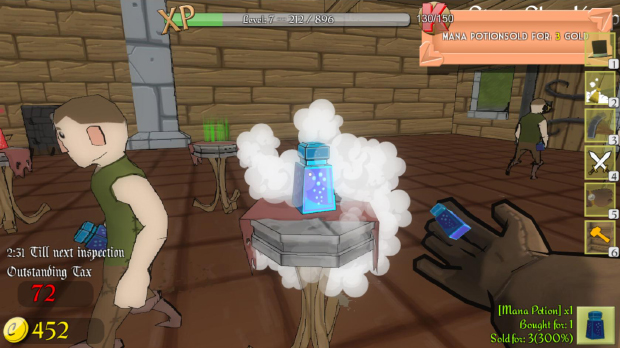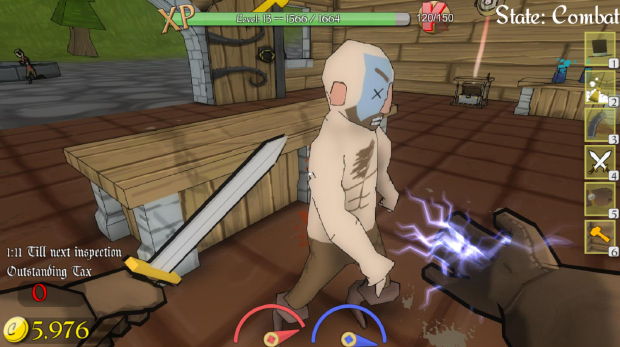Premature Evaluation: Shoppe Keep
Wares wally
Each week Marsh Davies peruses the scanty offerings of Early Access, stuffs anything halfway valuable down his trousers and legs it for the exit. This week, however, the tables have turned (or, at least, their percentage durability has decreased) as he plays Shoppe Keep [Steam page], a game about building up a retail enterprise in a medieval fantasy land.
Remember gamification? It makes work feel like a game! In most cases, that’s a really terrible, pointless game which crassly manipulates players to dubious benefit. But if we hadn’t already enough reasons to despise gamification’s necrotic touch, then it seems it has had the side effect of birthing a genre of games that feel like work. Of course, games are an ideal medium to playfully explore the sombre complexities and systems that underpin the real world, from simulations of corporate networks or car suspension to the strange psychology of commerce. But I think, more and more, we see games which are no more than the vapid appendage of numbers and accumulation that gamification had hitherto attempted to hammer on to other more worthwhile pursuits - only without the worthwhile pursuits themselves. Shoppe Keep’s premise of running a fantasyland supermarket is a good one - albeit explored before in the likes of Recettear - but it falls short of being a meaningful depiction of the intensely fascinating pressures that actually exist in retail. Though the later parts of the game begin to have the faintest tinge of strategy, for the most part it is an exercise in simple accumulation masked by an awful lot of plate-spinning. Or, given the sort of stuff you sell, plate-armour-spinning.
The game divides its challenge between spending your cash on stock orders and the panicky management of your storefront. In first person, you must sweep up the prodigious amount of dirt that customers continuously track in, refill shelves, and reset merchandise that the careless proles have knocked to the floor while bellowing “I don’t care very much!” in a Brummy accent. Sometimes, they’ll buy something, declaring, “I’m as well as can be!” or “You seem like a good mate!” and all those other things that people never say when they’re in shops. Periodically some blighter will try to make off with something, often while belching, and you’ll have to try and zap them with a lightning spell before they get out the door. At later levels, barbarians attack and smash up your furniture, and, once you’ve swept their corpses away, you’ll need to go around with a hammer tapping on your shelves and tables until they’re back up to 100% health. I’m probably making this sound more fun than it is.
Customer pathfinding occasionally breaks in the build I played, and peasants sometimes stopped dead on the shop floor. I can sympathise: while dealing with all the busywork keeps you physically occupied, the lack of mental engagement induces a sort of dismal fugue state. Though you’ll periodically have to order stock in and set prices, there isn’t any sort of robust economic simulation to make you consider these tasks in any depth. The price of commodities never fluctuates, and I’ve yet to detect any appreciable change in demand which might encourage me to modify my shop’s offering. The best strategy seems to be the only one: to slowly build up as broad a range as possible, starting with cheapo potions, working your way up through fancy studded gloves to heavy armour.
The game’s interface is comprehensively lacking - cluttered menus jabber at you in different fonts, not all of which seem to display well at whatever unchangeable resolution the game runs at. Some submenus have no means of going back up a level - though it’s hard to tell what’s a bug and what’s just an absent feature. Rather than just typing in numbers, setting prices involves repeatedly tapping the plus or minus symbols to set the percentage of cost price at which you are going to sell. This then becomes the global default (which occasionally and abruptly resets to 0%), meaning it’s a tremendous pain to set individual mark-ups for different items. I suspect this is an indication that such subtleties don’t matter. Customers seem to turn their nose up at anything over 300% anyway, and you’ll have to spend ages darting round the store resetting all the items they’ve knocked to the floor in disgust. You can buy a robot helper to pick things up, but it chooses to stuff collected items in a box rather than put them back on shelves, so you still have to do the work anyway. When buying stock, there’s no easy way to check what quantities of any item you already have, and to inspect your stock which has yet to be shelved you need to scroll through each sort of hat or sword individually, rather than just see a list. You have to pity the game whose UI is so woeful that it actually makes you want to do bookkeeping.
You’ll need new furniture to display your wares - podiums, benches, hat stands, weapon stands, shelves - though the game doesn’t tell you what can go on which thing, and it appears to arbitrarily and non-intuitively restrictive. Basic swords don’t go on weapon stands, but benches - and only on one side of them at that. You can’t move furniture once placed, only delete them and rebuy them at great cost. And you can only buy and place furniture when your shop is closed, which would be fine if I could work out how to close my shop. It has only ever happened once, and I have no idea why - it doesn’t seem to be related to the day night cycle. I found a way around this, however: save the game (by pressing 5 and then M, obviously), quit and reload, and the game restarts in a shop-closed state, allowing you to put everything in order. This strategy has its flaws: the game has, on occasion, simply failed to save and lost me days of tediously won progress.
This is annoying mostly because things threaten to become interesting only when you have a chunk of change set aside: in the early days of your business, you are beholden to a pretty linear set of decisions about what to buy, as that is all you can afford. With 10,000 in your pocket, you can expand your shop in one of several directions, double down on your quantity of stock, upgrade to fancier items, or buy more robot assistants to fry would-be thieves. There’s also a tech tree which allows you to add an electric security gate to the front of your store, attract richer customers, or force them to buy two items instead of one.
None of this quite manages to elevate the game from uniform drudgery, however - though I have hopes that it may as the game trundles onwards through Early Access. Currently, selectable “Quests” appear to challenge you to sell specific items, which you were probably going to do anyway at some point. Expanding your shop doesn’t materially change the nature of the decisions you make - of which there are precious few anyway - and by the time you can afford such expansion the tech tree is almost entirely unlocked, very little of which does more than massage numbers behind the scenes. Is there more subtlety to the game than first appears? Does the placement of items, say, make people more likely to buy them? Do customers tend to want things at different times of day? Is there any dynamism to the economy that might make this anything other than a linear accumulative grind hampered by makework? If there is, it needs to be placed front and centre. If there isn’t, it might be time for Shoppe Keep to sit back and take stock.
Shoppe Keep is available from Steam for £4. I played the version with the Build ID 771433 on 12/09/2015.





